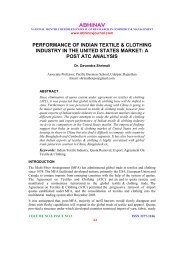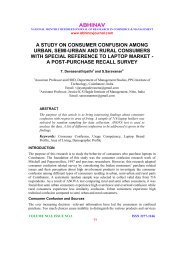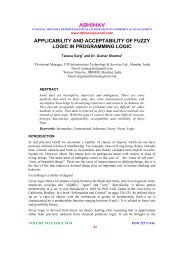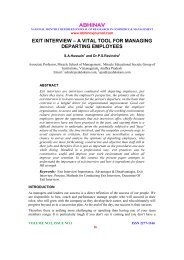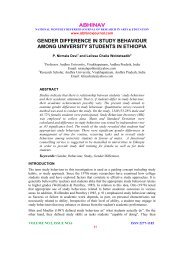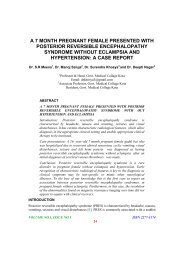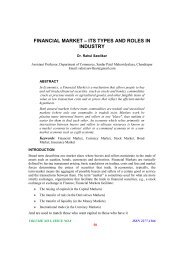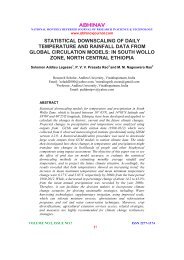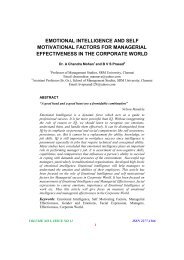A Study Of Consumer Acceptability For Noodles In Siliguri - Abhinav ...
A Study Of Consumer Acceptability For Noodles In Siliguri - Abhinav ...
A Study Of Consumer Acceptability For Noodles In Siliguri - Abhinav ...
Create successful ePaper yourself
Turn your PDF publications into a flip-book with our unique Google optimized e-Paper software.
A STUDY OF CONSUMER ACCEPTABILITY FOR<br />
NOODLES IN SILIGURI MARKET<br />
Subrata Ray<br />
Lecturer, Department of Management, University of North Bengal<br />
Email: page.subrata@gmail.com<br />
ABSTRACT<br />
<strong>For</strong> at least 2000 years the noodles have been a staple food in many parts of<br />
the world. The knowledge of early noodles came into being from the records<br />
which appeared in book written between A.D. 25 and 220 during China’s<br />
East Han dynasty. However, there are other theories which suggest that<br />
Arabs were the first to introduce noodles in Italy henceforth it has its origin<br />
in the Middle East. After the modern day appearance of noodles which is<br />
being dominated by the brands, the spread and consumption of noodles is<br />
growing day in and day out. The noodles market is growing at 20% annually<br />
in <strong>In</strong>dia. North Bengal is no exception to those trends. Here in this study<br />
North Bengal’s business centre <strong>Siliguri</strong> has been taken into consideration as<br />
an area of study. The reason for selecting this place can be summed up by<br />
understanding the fact that <strong>Siliguri</strong> has a cosmopolitan culture in its<br />
backdrop. The research methodology to be used is an empirical study which<br />
is tentatively planned for a definite sample size. The results show that a little<br />
aggressive marketing push ups for noodles by the branding companies can<br />
make a steady headway for them to bring in noodles into the plates of the<br />
<strong>Siliguri</strong> citizens to a large extent and can replace the other snacks too.<br />
Keywords: <strong>Noodles</strong>, <strong>Siliguri</strong> Citizens, North Bengal, Snacks<br />
INTRODUCTION<br />
Many fast food items have flooded the markets but noodles remained as the most popular<br />
item of all of them, as it is cheaper, very easy to make and nutritious. Urban and semi-urban<br />
markets are controlled by Maggi and other players are Top Ramen and other brands. Maggi<br />
has revolutionized the concept and this product has gone to majority of the urban<br />
households. As an off-shoot of this development, noodles have become very popular in<br />
<strong>In</strong>dia. Good quality and cheaper product can be pushed in the market with systematic<br />
strategy and network (mpstateagro.nic.in). The noodle is a type of staple food made from<br />
some type of unleavened dough which is rolled flat and cut into one of a variety of shapes.<br />
While long thin strips may be the most common, many varieties of noodles are cut into<br />
waves, helices, tubes, strings, and shells, folded over, or cut into other shapes. <strong>Noodles</strong> are<br />
usually cooked in boiling water, sometimes with cooking oil or salt added, but are often pan<br />
fried or deep fried. <strong>Noodles</strong> can be refrigerated for short-term storage, or dried and stored for<br />
future use. <strong>In</strong> English usage, the word "noodle" is an inclusive term that denotes texture and<br />
VOLUME NO.1, ISSUE NO.9 ISSN 2277-1166<br />
57
ABHINAV<br />
NATIONAL MONTHLY REFEREED JOURNAL OF REASEARCH IN COMMERCE & MANAGEMENT<br />
www.abhinavjournal.com<br />
culinary use, and to a lesser extent, shape, as many people may associate it with the more<br />
common string varieties, such as spaghetti or ramen. Material composition or geo-cultural<br />
origin must usually be specified. However, the actual word derives from the German Nudel.<br />
The current version of noodles has been around for over half a century on the global menu<br />
card. They are believed to have been invented by Momofuku Ando, the founder of Nissin<br />
Food Products in 1958 in Japan. Packaged under the brand name Chikin Ramen, they were<br />
priced around six times that of traditional Japanese noodles and were considered a luxury<br />
item (The Economic Times, 2011). However, in 2005 an evidence of the oldest noodles is<br />
believed to be found, which were discovered inside an overturned sealed bowl buried under<br />
three meters of sediment in Qinghai, northwest China. Scientists determined the 4,000 year<br />
old, long, thin yellow noodles were made from broomcorn millet and foxtail millet and show<br />
a fairly high level of food processing and culinary sophistication. A noodle includes all<br />
varieties from all origins, but wherever they originated, noodles have maintained their<br />
popularity over the centuries and owe their longevity to a combination of being relatively<br />
cheap yet nutritious and filling, quick to prepare, can be eaten hot or cold, can be stored for<br />
years and can be transported easily. The Traditional Japanese diet included huge amounts of<br />
rice. Even today a small bowl of rice is served with almost every meal, including breakfast.<br />
Originally from China, noodles have become an essential part of Japanese cuisine, usually as<br />
an alternative to a rice-based meal. Soba, thin brown noodles made from buckwheat, and<br />
udon, thick wheat noodles, are the traditional noodles, served hot or cold with soy-dashi<br />
flavorings. Another popular Chinese wheat noodle, Ramen, is served hot in a meat stock<br />
broth (hakubaku.com).<br />
The Growing Global Market of <strong>Noodles</strong><br />
With the overwhelming pace of modern man’s busy lifestyles, set by increased working<br />
time, heavier traffic, growing importance given to workouts and healthy existence, people<br />
have an ever dwindling free time at their disposal and thereby demand more convenience<br />
foods and ready meals. Hurried lifestyles brought upon by the growing number of women<br />
working, has triggered a shift in cooking habits away from conventional time consuming<br />
preparation of fresh foods to easy precooked, easy to prepare meals. With consumers having<br />
less time to cook meals at home and with the contemporary mom no longer cooking, the task<br />
of preparing foods is transferred to the food processor. <strong>In</strong>creasing number of nuclear<br />
families, rise in disposable incomes, young singles with little or no cooking skills, enhanced<br />
awareness of healthful diets and increased interest in ethnic and international foods,<br />
represent additional factors that are expected to have a bearing on eating and food<br />
preparation habits. As the next generation of convenient ready and easy to prepare foods hit<br />
the market, noodles, as a product category, banking on its strength of convenience are poised<br />
to encounter days of plenty in the upcoming years. <strong>Noodles</strong> are finely tuned to fit into the<br />
consumers’ ever-dwindling cooking time schedules. The trend of cooking meals in just a few<br />
minutes is gaining momentum not only among individual consumers but also among<br />
institutions and public food outlets. Even restaurants and fast food joints are turning to<br />
convenience food to meet the ever-busy consumers demand for quick service and quality<br />
food (GIA, 2011).<br />
Asia-Pacific represents the largest regional market for noodles worldwide, as stated by the<br />
new market research report on <strong>Noodles</strong>. The region is portended to continue its dominance<br />
VOLUME NO.1, ISSUE NO.9 ISSN 2277-1166<br />
58
ABHINAV<br />
NATIONAL MONTHLY REFEREED JOURNAL OF REASEARCH IN COMMERCE & MANAGEMENT<br />
www.abhinavjournal.com<br />
over the coming years. The United States trails Asia-Pacific in terms of sales of noodles.<br />
Growth-wise, Middle East/Africa is projected to be the fastest growing regional market for<br />
noodles, with a CAGR of more than 13% over the analysis period. The research report titled<br />
“<strong>Noodles</strong>: A Global Strategic Business Report” announced by Global <strong>In</strong>dustry Analysts <strong>In</strong>c.,<br />
provides a comprehensive review of the noodles markets, impact of recession on the<br />
markets, current market trends, key growth drivers, recent product introductions, recent<br />
industry activity, and profiles of major/niche global as well as regional market participants<br />
(GIA, 2011).<br />
Asia currently propels the global instant noodle market - estimated to be worth some US$25<br />
billion - with an 80 per cent share. The continent's history of eating noodles is part of the<br />
reason why it is more popular here. The world today chomps through some 92 billion<br />
servings of noodles (led by China, who contribute to about half of that) a year. World<br />
<strong>Noodles</strong> Association (WINA), chairman Mr. Koki Ando reckons it won't be long before they<br />
break the 100 billion mark (Cheng, 2012).<br />
Unlike in other parts of the world, noodles are a mainstream food category in Asia-Pacific,<br />
making it the single largest producer and consumer in the world, as stated by the new market<br />
research report. The region, led by relentless demand from the Chinese and Hong Kong<br />
markets, is portended to continue its dominance over the coming years. Emerging over the<br />
Asian horizon is China that is recording massive production and consumption figures. With<br />
relatively low annual per capita consumption levels compared to other Asian counterparts,<br />
China represents a potential market for noodles. <strong>Noodles</strong> in Middle East/Africa are<br />
experiencing a growth in the demand, with the introduction of newer products into the<br />
market and are poised to grow at a strong compounded annual growth rate (CAGR) over the<br />
long-term (GIA, 2012).<br />
<strong>Noodles</strong> Market in <strong>In</strong>dia<br />
<strong>In</strong> the early 80s, the conservative and typical food consumption era, the concept of ‘ready-tocook’<br />
food was alien to the <strong>In</strong>dian market. People were doubtful to experiment with food<br />
especially food meant for their children. Despite the unfavorable circumstances, Swiss giant<br />
Nestle with its brand Maggi took the challenge and launched itself in 1983. The brand’s<br />
appropriate realization of target segment, effective positioning and effective promotion and<br />
sales made Maggi the most-loved noodle brand in <strong>In</strong>dia. Maggi enjoys a market share of<br />
over 70% today, despite the presence of a number of other brands. <strong>In</strong> 2005, the Maggi brand<br />
was worth USD 3.7 billion in comparison to USD 1.7 billion recorded in 2003. <strong>In</strong> 2005,<br />
Maggi was the highest <strong>In</strong>dian spender in the Sales Promotion department in the <strong>Noodles</strong><br />
Category. However, in recent times Maggi has been seeing a flurry of activity with new<br />
entrants stocking the shelves in recent months. Be it GlaxoSmithKline's Horlicks Foodles,<br />
Hindustan Unilever’s Knorr Soupy <strong>Noodles</strong>, or ITC's Sunfeast Yippee, each is out to grab a<br />
share of the consumer’s palate and wallet. It may not reach the levels of the Pepsi vs. Coke<br />
“Cola Wars” of the 1980s, but the signs of a major skirmish in the making are clearly visible<br />
in <strong>In</strong>dia’s food sector. <strong>In</strong> <strong>In</strong>dia, they were made popular by Nestle, which introduced its<br />
product here under the brand name “Maggi” in 1984. Market estimates put the noodles sector<br />
in the country currently at around Rs. 1,300 crore (US$288 million) and growing at around<br />
15% to 20% annually. According to reports of market research firm Nielsen, on an all-<strong>In</strong>dia<br />
basis across urban markets, Maggi has been steadily losing market share to the new entrants<br />
VOLUME NO.1, ISSUE NO.9 ISSN 2277-1166<br />
59
ABHINAV<br />
NATIONAL MONTHLY REFEREED JOURNAL OF REASEARCH IN COMMERCE & MANAGEMENT<br />
www.abhinavjournal.com<br />
(The Economic Times, 2011). However, Maggi still controls a lion’s share of instant noodles<br />
market and it will not be an easy task for new entrants to throw this giant off the pedestal so<br />
soon. The only serious competition Maggi had until now was from the Japan-based Nissin<br />
Group's Top Ramen, but it failed to make any major impact in the market. Also, Nestle has<br />
been continuously adding new categories and successful brand extensions to retain its<br />
numero uno status. Thus, the newly launched whole-wheat based flavour is an attempt to<br />
capture the palette of health aficionado and the introduction of cuppa-noodles is a move to<br />
upscale itself from the snack food of children to provide varied options to the younger<br />
audience to have noodles while on the move (Sharma, 2011).<br />
From the days of a fringe dish targeted at children the noodles as a food has come a long<br />
way. Today, it has evolved as a mainstay meal even for grown-ups. The noodles market<br />
players as competitor’s now have deep pockets and they are in for long drag of noodles<br />
market share battle. GSK, Unilever, and ITC are players who have got well-oiled supply<br />
chain networks, vast distribution reach and intricate marketing network in both urban and<br />
rural areas (Sharma, 2011). With changing social ethos and the rise of demographic profile<br />
the fast food category is witnessing feat after feat in recent times. The noodles market will is<br />
currently experiencing a great battle in recent times.<br />
<strong>Siliguri</strong> and Its <strong>Noodles</strong> Market<br />
<strong>Siliguri</strong> is described as the gateway to the North East of <strong>In</strong>dia, Bhutan, Nepal and<br />
Bangladesh. The strategic location of the city in North Bengal (in the state of West Bengal)<br />
makes it a base for essential supplies to the above regions. <strong>Siliguri</strong> has gradually developed<br />
as a profitable centre for a variety of businesses in this part of West Bengal. As a central hub,<br />
many national companies and organizations have set up their offices in this city. The local<br />
market place is known as a chief hub for buying low cost foreign goods and imported goods.<br />
Apart from this the nearby markets of <strong>Siliguri</strong> are also considered to be the prominent places<br />
of the city to buy daily use goods, and is very popular among people from nearby areas of<br />
<strong>Siliguri</strong>. The four “T”s - Tea, Timber, Tourism and Transport - are the main businesses of<br />
<strong>Siliguri</strong>. Although, the economy of the North Bengal region is largely dependent upon the<br />
tea and tourism industry, it is not the same with <strong>Siliguri</strong>. The business machinery in the city<br />
mainly consists of retailers, wholesalers, dealers, distributors and small scale entrepreneurs.<br />
<strong>Siliguri</strong>, being a centre of trade and commerce in the region, has great prospects for the<br />
FMCG and consumer goods industry as well. <strong>In</strong>dustries like bakery and confectionary,<br />
biscuits, sports goods, incense sticks, mineral water, soaps, chalk and pencils, digital clocks<br />
etc., can have a huge market and even small entrepreneurs can take advantage of this<br />
opportunity. There is also a good market for steel utensils, leather shoes, ready-made<br />
garments, tin containers, plastic articles, kitchen wares, electrical accessories etc<br />
(www.siligurionline.com).<br />
However, with the flurry in the rise of nature tourism destinations in the outskirts of <strong>Siliguri</strong><br />
has lead to the development of hospitality business in this city in recent times. Now, the<br />
hospitality sector and tourism sector constitutes an important part of <strong>Siliguri</strong>’s economy. <strong>Of</strong><br />
late, there is the rise of retail chains in the city with the inauguration of ‘Cosmos’, ‘Orbit’<br />
and Ambuja Realties’ ‘City Centre, <strong>Siliguri</strong>’. The city recently also witnessed the arrival of<br />
multiplexes. With the growing economic transactions of the city it has increased the chances<br />
of various opportunities of FMCG companies to increase its operations in <strong>Siliguri</strong> as major<br />
VOLUME NO.1, ISSUE NO.9 ISSN 2277-1166<br />
60
ABHINAV<br />
NATIONAL MONTHLY REFEREED JOURNAL OF REASEARCH IN COMMERCE & MANAGEMENT<br />
www.abhinavjournal.com<br />
marketing hub of North Bengal. <strong>Siliguri</strong> has experienced a huge surge in population in recent<br />
times. Based on Census data of 2011, the city agglomeration had a population of 701,489.<br />
Males constitute 51% of the population and females 49%. <strong>In</strong> <strong>Siliguri</strong>, 10% of the population<br />
is under six years of age. <strong>Siliguri</strong> has a majority Bengali population. Other minority<br />
communities include Gorkhas, Marwaris and Biharis. Bengali, Hindi, English, Nepali,<br />
Marwari, Bihari, Bhojpuri, Assamese, Punjabi, Gujrati, and Tibetan languages are spoken by<br />
the local people of <strong>Siliguri</strong>. <strong>Siliguri</strong> has seen waves of enormous migration over the years,<br />
most prominent being the migrants from the erstwhile East Bengal during the Partition of<br />
<strong>In</strong>dia, Nepal and Bihar. <strong>In</strong> addition, people from Jharkhand and other parts of <strong>In</strong>dia have also<br />
come to the city in search of livelihood (Times of <strong>In</strong>dia, 2001).<br />
This growth of population especially in the middleclass sections of this <strong>Siliguri</strong> region has<br />
presented an opportunity for the FMCG sectors (especially for the food manufacturers like<br />
noodles and instant fast foods) to have their pie from the cake. Mushrooming <strong>In</strong>dian<br />
population, particularly the middle class and the rural segments, presents the huge<br />
opportunity to FMCG players in a situation where there is a change in the food habits due to<br />
several reasons like <strong>In</strong>dia’s young demographic profile, increasing family income,<br />
accelerating urbanization, the cosmopolitization of major urban centers, unprecedented<br />
interstate migrations, increasing number of working couples, time constraints, shortage of<br />
household help, global travel, and increasing exposure to global cuisine and so on.<br />
According to Harminder Sahni, managing director of Wazir Consultants, a firm that focuses<br />
on brands and the retail space, the localization of cuisines to match customer tastes<br />
regionally has played a major role in the acceptability of different cuisines in this country<br />
(The Economic Times, 2011). Growth is also likely to come from consumer ‘upgrading’ in<br />
the matured product categories like processed and packaged food, mouth wash etc (Vora,<br />
2011). The scenario of noodles Market of North Bengal is also not much different from other<br />
parts of the country. Wai Wai commands the highest market share in North Bengal and<br />
North eastern states combined (Mukul, 1999). Next are Maggie and Top Ramen, which are<br />
the national branded instant noodles available in most of the retail shops. Unbranded locally<br />
manufactured noodles also available and bulkily purchased by the Restaurants and fast-food<br />
centers.<br />
<strong>Siliguri</strong> is also being considered in this category of developing cities of <strong>In</strong>dia. As a matter of<br />
fact, the study carried out in <strong>Siliguri</strong> region is arguably having a great importance in the days<br />
to come for the manufacturers of noodles operating in this region or are planning to invest in<br />
this sector presuming growth in the noodles markets especially from this region.<br />
OBJECTIVES OF THE STUDY<br />
Here in this study of the consumer’s acceptability of noodles is being considered from the<br />
consumer’s point of view about their perception purchasing noodles for consumptions. This<br />
has been taken into consideration because noodles have been considered as a convenience<br />
food (www.hubpages.com). Convenience has an immense impact on the food choices of<br />
today’s consumers (Wales, 2009). The other convenient food stuff available had a very little<br />
impact unlike that of noodles (due to its instant cooking and ready-to-eat attribute).<br />
However, analyzing the noodles as a food of the masses can enable us get an overall<br />
viewpoint about the market trends of the customer’s acceptance of noodles as an important<br />
food in this region of <strong>Siliguri</strong>. Various factors were being considered while framing the<br />
VOLUME NO.1, ISSUE NO.9 ISSN 2277-1166<br />
61
ABHINAV<br />
NATIONAL MONTHLY REFEREED JOURNAL OF REASEARCH IN COMMERCE & MANAGEMENT<br />
www.abhinavjournal.com<br />
objectives of the study which may be stated as the consumer’s perception about the<br />
consumer’s behaviour towards noodles as a food, the consumer’s brand parity perception<br />
about noodles, consumer styles while purchasing noodles as a food item etc.<br />
From the study some of the important research questions which are addressed and are related<br />
to the consumer’s acceptability of noodles as an important food in <strong>Siliguri</strong> region. These<br />
questions are as follows:<br />
1. Does the favourable consumer behaviour in noodles purchase by the consumers have<br />
any impact on the consumer’s brand parity perception about noodles<br />
2. Does the favourable consumer behaviour in noodles purchase by the consumers have<br />
any impact on the consumer’s style of purchasing noodles<br />
3. Does the consumer’s brand parity perception about noodles have any impact on the<br />
consumer’s style of purchasing noodles<br />
These research questions are being addressed through the statistical analysis carried out by<br />
processing the data obtained during the course of study.<br />
METHOD<br />
Plan of the <strong>Study</strong><br />
The planning of the study involved the initial study and the development of blueprint of the<br />
entire market and the clients and customers. Strategies have been taken to go along with the<br />
study. As already stated and also in being evident from the title of the study that the research<br />
work basically dealt with consumer acceptability of noodles in <strong>Siliguri</strong> region. A pilot study<br />
was being carried out for gaining a clear picture about the tentative questions to be asked to<br />
the probable respondents (who happens to be the consumers of noodles). Based on the initial<br />
pilot survey a final questionnaire was being developed which was later administered to the<br />
respondents to get the feedbacks about noodles and their perceptions about noodles and their<br />
acceptance of noodles as an important food preference. The main plan was to do the pilot<br />
survey, develop the questionnaire, respondent selection, collecting the responses from the<br />
respondents, data compilation and finally the analysis of the same.<br />
The scales that were used in developing the questionnaire for getting the data from the<br />
consumer respondents are as follows:<br />
Exploratory Tendencies in <strong>Consumer</strong> Behaviour (ETCB) Scale: This scale basically<br />
was developed by P. S. Raju in his research work titled “Optimum Stimulation<br />
Level: Its Relationship in Personality, Demographics, and Exploratory Behavior”<br />
which was published in the Journal of <strong>Consumer</strong> Research in the year 1980. Here in<br />
this study this scale is used as a variable related towards Favorable <strong>Consumer</strong><br />
Behaviour in <strong>Noodles</strong> purchase.<br />
Perceived Brand Parity (PBP) Scale: This scale basically was developed by James.<br />
A. Muncy in his research work titled “Measuring Perceived Brand Parity” which<br />
was published in the journal titled Advances in <strong>Consumer</strong> Research in the year 1996.<br />
Here in this study this scale is used as a variable related towards Brand Parity<br />
perception about <strong>Noodles</strong>.<br />
VOLUME NO.1, ISSUE NO.9 ISSN 2277-1166<br />
62
ABHINAV<br />
NATIONAL MONTHLY REFEREED JOURNAL OF REASEARCH IN COMMERCE & MANAGEMENT<br />
www.abhinavjournal.com<br />
<strong>Consumer</strong> Styles <strong>In</strong>ventory (CSI) Scale: This scale basically was developed by<br />
George B. and Elizabeth Kendall in their research work titled “A Methodology for<br />
Profiling <strong>Consumer</strong>s Decision Making Styles” which was published in the journal<br />
titled Journal of <strong>Consumer</strong> Affairs in the year 1986. Here in this study this scale is<br />
used as a variable related towards <strong>Consumer</strong>’s Style of Purchasing <strong>Noodles</strong>.<br />
Sample Methodology<br />
The nature of the sample principally is the respondents of the study who also happen to be<br />
the end consumers of noodles (or the probable end-consumers of noodles). A random<br />
selection of the sample is being considered for the study. The respondents or the study is<br />
spread among the class of consumers based on the gender, age group, educational<br />
qualifications, income status etc. It is to be noted that the efforts were made to execute the<br />
criteria spread on the total respondents uniformly so as to have full depiction of the<br />
population within the whole sample size. <strong>In</strong>itially, the total sample was thought to be<br />
approximately around 250. However, eventually the total sample size in the study became<br />
244 effectively. This is because the questionnaire which was circulated among the<br />
respondents for receiving responses, however, when the responses were collected it was just<br />
244 only. Further, when a methodical analysis was done based on the responses, it was found<br />
that a total of 6 numbers of responses were found to be either erroneous or unfinished.<br />
Henceforth, there were no alternative left and those responses were discarded. So, ultimately<br />
in the study we received total effective responses of 244.<br />
Data Collection<br />
The responses were collected from the total sample size which was pre-identified during the<br />
plan of the study. <strong>In</strong>itially, the questionnaire was given to the probable respondents and the<br />
detailing was done about the process of filling up of the questionnaire. The questionnaire,<br />
which was selected for the study contained 15 close ended questions about noodles and the<br />
perception of the respondents about noodles. The respondents were supposed to answer those<br />
questions by ticking the option which they feel it right. The answer choices were made<br />
according to Likert scale with 5 options, starting from fully agree in one side and fully<br />
disagree in the continuum. As far as the scoring is concerned it was done in a reverse order<br />
i.e. 5 for fully agree, 4 for partially agree, 3 for can’t say and likewise. Further, the<br />
questionnaire also contained a second part related to the demographic profile detailing about<br />
the respondents. The respondents were also supposed to rightly answer those options too.<br />
During the course of study a total 10 days was initially planned for the response collection.<br />
<strong>In</strong> accordance to that after 10 days of the questionnaire distribution the responses were<br />
collected from the respondents. However, it was found that 70 percent of the responses<br />
remained unattended. Henceforth, the response collection time was extended to more 7 days<br />
from the initial 10 days decided earlier. During the next 7 days extra effort were given to<br />
ensure that maximum of the respondent fills the questionnaire appropriately. No, further<br />
extension of the cutoff date was entertained for collection of the responses.<br />
RESULTS AND DISCUSSIONS<br />
The statistical tools used in the study are the descriptive statistics, the paired sample statistics<br />
of the responses and reliability analysis. After applying those statistical analyses we came to<br />
certain conclusions of the study. The descriptive statistics are presented in the table where<br />
VOLUME NO.1, ISSUE NO.9 ISSN 2277-1166<br />
63
Pair 3<br />
Pair 2<br />
Pair 1<br />
ABHINAV<br />
NATIONAL MONTHLY REFEREED JOURNAL OF REASEARCH IN COMMERCE & MANAGEMENT<br />
www.abhinavjournal.com<br />
we have reported the measures of central tendencies and the measures of dispersion by<br />
standard deviation. On the whole, it is observed that the mean, median, and modes are very<br />
closure to each other, suggesting a normal distribution and the dispersion is quiet low.<br />
Table 1. Descriptive Statistics<br />
N Mean Median Mode<br />
Std.<br />
Deviation<br />
Favorable <strong>Consumer</strong> Behaviour in <strong>Noodles</strong><br />
purchase<br />
244 39.7213 43.0000 43.00 7.71537<br />
Brand Parity perception about <strong>Noodles</strong> 244 7.0451 7.0000 7.00 2.04125<br />
<strong>Consumer</strong>’s Style of Purchasing <strong>Noodles</strong> 244 12.6803 13.0000 13.00 3.58843<br />
Valid N (list wise) 244<br />
<strong>In</strong> the next table the results of the descriptive statistics are shown where the mean, median<br />
and the mode of the variables of the scales are highlighted.<br />
Table 2. Paired Samples Statistics<br />
Mean<br />
VOLUME NO.1, ISSUE NO.9 ISSN 2277-1166<br />
64<br />
N<br />
Std.<br />
Deviation<br />
Std. Error<br />
Mean<br />
Favorable <strong>Consumer</strong> Behaviour in<br />
<strong>Noodles</strong> purchase<br />
39.7213 244 7.71537 .49393<br />
Brand Parity perception about <strong>Noodles</strong> 7.0451 244 2.04125 .13068<br />
Favorable <strong>Consumer</strong> Behaviour in<br />
<strong>Noodles</strong> purchase<br />
39.7213 244 7.71537 .49393<br />
<strong>Consumer</strong>’s Style of Purchasing <strong>Noodles</strong> 12.6803 244 3.58843 .22973<br />
Brand Parity perception about <strong>Noodles</strong> 7.0451 244 2.04125 .13068<br />
<strong>Consumer</strong>’s Style of Purchasing <strong>Noodles</strong> 12.6803 244 3.58843 .22973<br />
<strong>In</strong> this study a sample size of 244 respondents were taken into consideration for interviewing<br />
regarding the consumer behaviour of purchasing noodles in an around <strong>Siliguri</strong> city. It has<br />
been found for the case of pair 1, the favorable consumer behaviour of purchasing noodles<br />
scores in an average of 39.72 with a standard deviation of 7.71 with the behavior of the<br />
consumers. Furthermore, according to the same respondents the brand parity perception<br />
about noodles scores in an average of 7.04 with a standard deviation of 2.04 from their point<br />
of understanding the brand parity about noodles by the consumers of <strong>Siliguri</strong>. <strong>For</strong> the case of<br />
pair 2 it has been found that the favorable consumer behaviour of purchasing noodles scores<br />
in an average of 39.72 with a standard deviation of 7.71 with the behavior of the consumers.<br />
Furthermore, according to the same respondents the consumer’s style of purchasing noodle<br />
scores in an average of 12.68 with a standard deviation of 3.58 from the style of purchasing<br />
noodles by the consumers of <strong>Siliguri</strong>. Lastly for the case of pair 3, the brand parity<br />
perception of the consumers about noodles scores in an average of 7.04 with a standard<br />
deviation of 2.04 their point of understanding the brand parity about noodles by the<br />
consumers of <strong>Siliguri</strong>. Furthermore, according to the same respondents the consumer’s style<br />
of purchasing noodle scores in an average of 12.68 with a standard deviation of 3.58 from<br />
the style of purchasing noodles by the consumers of <strong>Siliguri</strong>.
Pair 2<br />
Pair 1<br />
Pair 3<br />
Pair 2<br />
Pair 1<br />
ABHINAV<br />
NATIONAL MONTHLY REFEREED JOURNAL OF REASEARCH IN COMMERCE & MANAGEMENT<br />
www.abhinavjournal.com<br />
Table 3. Paired Samples Correlations<br />
Favorable <strong>Consumer</strong> Behaviour in <strong>Noodles</strong><br />
purchase & Brand Parity perception about<br />
<strong>Noodles</strong><br />
Favorable <strong>Consumer</strong> Behaviour in <strong>Noodles</strong><br />
purchase & <strong>Consumer</strong>’s Style of<br />
Purchasing <strong>Noodles</strong><br />
N<br />
Correlation Sig.<br />
244 .677 .000<br />
244 .427 .000<br />
Brand Parity perception about <strong>Noodles</strong> &<br />
<strong>Consumer</strong>’s Style of Purchasing <strong>Noodles</strong><br />
244 .370 .000<br />
From the above table for the case of pair 1, the r =.67 so we can reject the null hypothesis.<br />
Henceforth, there is insufficient evidence to conclude that population correlation is different<br />
from 0. Secondly, for the case of pair 2, the r =.42 so we can reject the null hypothesis.<br />
Henceforth, there is insufficient evidence to conclude that population correlation is different<br />
from 0. Lastly, for the case of pair 3, the r =.37 so we can reject the null hypothesis.<br />
Henceforth, there is insufficient evidence to conclude that population correlation is different<br />
from 0.<br />
Favorable <strong>Consumer</strong><br />
Behaviour in <strong>Noodles</strong><br />
purchase - Brand Parity<br />
perception about<br />
<strong>Noodles</strong><br />
Favorable <strong>Consumer</strong><br />
Behaviour in <strong>Noodles</strong><br />
purchase - <strong>Consumer</strong>’s<br />
Style of Purchasing<br />
<strong>Noodles</strong><br />
about <strong>Noodles</strong> -<br />
<strong>Consumer</strong>’s Style of<br />
Purchasing <strong>Noodles</strong><br />
Pair 3 Brand Parity perception<br />
Mean<br />
Table 4. Paired Samples Test<br />
Std.<br />
Deviation<br />
Paired Differences<br />
Std.<br />
Error<br />
Mean<br />
95% Confidence<br />
<strong>In</strong>terval of the<br />
Difference<br />
Lower Upper<br />
VOLUME NO.1, ISSUE NO.9 ISSN 2277-1166<br />
65<br />
t<br />
df<br />
Sig. (2-<br />
tailed)<br />
32.676 6.50970 .41674 31.85534 33.49712 78.40 243 .000<br />
27.040 6.98251 .44701 26.16048 27.92149 60.49 243 .000<br />
-5.635 3.40934 .21826 -6.06517 -5.20532 -25.81 243 .000<br />
From the above table for the case of pair 1, since α value is .000 is less than.05, so we reject<br />
the null hypothesis. That implies that there is sufficient evidence to conclude that the<br />
favourable consumer behaviour in noodles purchase by the consumers do have an impact on<br />
the consumer’s brand parity perception about noodles. Secondly, for the case of pair 2, since<br />
α value is .000 is less than.05, so we reject the null hypothesis. That implies that there is<br />
sufficient evidence to conclude that the favourable consumer behaviour in noodles purchase
ABHINAV<br />
NATIONAL MONTHLY REFEREED JOURNAL OF REASEARCH IN COMMERCE & MANAGEMENT<br />
www.abhinavjournal.com<br />
by the consumers do have an impact on the consumer’s style of purchasing noodles. Lastly,<br />
for the case of pair 3, since α value is .000 is less than.05, so we reject the null hypothesis.<br />
That implies that there is sufficient evidence to conclude that the consumer’s brand parity<br />
perception about noodles do have an impact on the consumer’s style of purchasing noodles.<br />
<strong>In</strong> the reliability analysis of the customer responses we have conducted a reliability analysis<br />
in finding out the alpha value of the responses in the different scales adopted within the<br />
questionnaire. It is being found that the alpha value of the scales is more than 0.6733 for all<br />
the variables which is acceptable but however, not very high. Regarding the Favorable<br />
<strong>Consumer</strong> Behaviour in <strong>Noodles</strong> purchase scale that included 10 items generated an alpha<br />
value of 0.8916 and subsequently the Brand Parity perception about <strong>Noodles</strong>, and<br />
<strong>Consumer</strong>’s Style of Purchasing <strong>Noodles</strong> scales generated a value of 0.8049 and 0.6733<br />
respectively. Furthermore it is also to be noted that the items included in the above scales are<br />
2 and 3 respectively. <strong>In</strong> view of the number of the items included in the later scales of the<br />
questionnaire we can say that the alpha value is towards the higher end. As a matter of factly,<br />
the co-efficient in general show a good degree of internal consistency. The reliability<br />
statistics of the scales are given in the following table.<br />
Table 5. Reliability Statistics<br />
Variables Cronbach’s Alpha Number of Items<br />
Favorable <strong>Consumer</strong> Behaviour in <strong>Noodles</strong><br />
purchase<br />
0.8916 10<br />
Brand Parity perception about <strong>Noodles</strong> 0.6733 2<br />
<strong>Consumer</strong>’s Style of Purchasing <strong>Noodles</strong> 0.8049 3<br />
The regression analysis of the data is also being carried out with a motive of finding the<br />
significant relationships between the variables used in the study. We have entered the<br />
following variables shown in the following table.<br />
Table 6. Model Summary<br />
Model R R Square Adjusted R Square Std. Error of the Estimate<br />
1 .703 a .494 .490 5.50980<br />
Note: a. Predictors: (Constant), <strong>Consumer</strong>’s Style of Purchasing <strong>Noodles</strong>, Brand Parity<br />
perception about <strong>Noodles</strong><br />
Table 7. ANOVA b<br />
Model Sum of Squares df Mean Square F Sig.<br />
1 Regression 7148.800 2 3574.400 117.742 .000 a<br />
Residual 7316.249 241 30.358<br />
Total 14465.049 243<br />
Note: a. Predictors: (Constant), <strong>Consumer</strong>’s Style of Purchasing <strong>Noodles</strong>, Brand Parity<br />
perception about <strong>Noodles</strong><br />
b. Dependent Variable: Favorable <strong>Consumer</strong> Behaviour in <strong>Noodles</strong> purchase<br />
VOLUME NO.1, ISSUE NO.9 ISSN 2277-1166<br />
66
ABHINAV<br />
NATIONAL MONTHLY REFEREED JOURNAL OF REASEARCH IN COMMERCE & MANAGEMENT<br />
www.abhinavjournal.com<br />
Table 8. Coefficients a<br />
Model<br />
Unstandardized<br />
Coefficients<br />
Standardized<br />
Coefficients t Sig.<br />
B Std. Error Beta<br />
(Constant) 18.135 1.533 11.831 .000<br />
1<br />
Brand Parity perception about <strong>Noodles</strong> 2.272 .186 .601 12.189 .000<br />
<strong>Consumer</strong>’s Style of Purchasing<br />
.440 .106 .205 4.151 .000<br />
<strong>Noodles</strong><br />
Note: a. Dependent Variable: Favorable <strong>Consumer</strong> Behaviour in <strong>Noodles</strong> purchase<br />
The findings of the regression analysis amply demonstrate that there exists a significant<br />
relationship between the Favorable <strong>Consumer</strong> Behaviour in <strong>Noodles</strong> purchase, Brand Parity<br />
perception about <strong>Noodles</strong> and <strong>Consumer</strong>’s Style of Purchasing <strong>Noodles</strong>. The value of<br />
adjusted R square is found to be highly significant considering the F value given in the<br />
ANOVA table. Both Brand Parity perception about <strong>Noodles</strong> and <strong>Consumer</strong>’s Style of<br />
Purchasing <strong>Noodles</strong> significantly influence the Favorable <strong>Consumer</strong> Behaviour in <strong>Noodles</strong><br />
purchase. However, the Brand Parity perception about <strong>Noodles</strong> influence on Favorable<br />
<strong>Consumer</strong> Behaviour in <strong>Noodles</strong> purchase is higher than the <strong>Consumer</strong>’s Style of Purchasing<br />
<strong>Noodles</strong>. The t values are quiet high and both are significant beyond P
ABHINAV<br />
NATIONAL MONTHLY REFEREED JOURNAL OF REASEARCH IN COMMERCE & MANAGEMENT<br />
www.abhinavjournal.com<br />
advisable to keep the conversation light and friendly. Passing out informational fliers about<br />
noodles as an important food stuff is an additional way to share information.<br />
Distributing Printed Materials about <strong>Noodles</strong> and the Manufacturing Units<br />
Sales managers especially from the local production companies can try in for some<br />
innovative techniques like combining the name of the production unit with the type of<br />
noodles manufactured in it. This can be associated with a unique type style and color scheme<br />
to for creating unique logos for the purpose. Once those have been created this design and<br />
identity, it can be used consistently on all printed and online materials related to the noodles<br />
brands. Customers are more likely to remember those products which have a strong and<br />
consistent identity.<br />
Addressing Post Sales Dissatisfaction<br />
Managers may take an important initiative of addressing any post-sale dissatisfaction politely<br />
and promptly related to the noodles sales. This can be done in collaboration with the<br />
distributing networks of the product. It is very important to acknowledge all complaints,<br />
apologize and take appropriate steps to remedy the complaint associated with the noodles<br />
brand. It is sometimes helpful to ask customers how they would like the product to be.<br />
Thanking the customer/respondents for bringing the complaint to your attention and make a<br />
note of the issue for future reference is also important. It can be said that it takes more<br />
energy and effort to gain new customers than it does to keep existing ones. Even when a<br />
customer has a negative experience, they will likely return to purchase the product again if<br />
they feel their complaint was resolved in an appropriate and timely way.<br />
Customized Service <strong>Of</strong>ferings from <strong>Noodles</strong> Brands<br />
<strong>Noodles</strong> sales managers can ensure the providence good service is particularly essential for<br />
restaurant customers. <strong>Noodles</strong> samples can introduce the product to a chef, but they have to<br />
be packaged well and contain enough of your product so that the chef can experiment. Good<br />
packaging of noodles will allow it to show visibly if possible, will be consistent from<br />
package to package, and will be standardized by weight or count, so a chef can confidently<br />
order the necessary amount. <strong>For</strong> the local made noodles brand it’s easier to deliver<br />
customized packages however, for the national brands innovations can be ensured by the<br />
managers.<br />
CONCLUSIONS<br />
From the study an attempt has been made to put forward the factors associated with noodles<br />
selling and the perception of the consumers towards noodles (considering it as a basic food)<br />
especially from <strong>Siliguri</strong>. Further, in the study some areas unique to the selling of noodles in<br />
<strong>Siliguri</strong> region were highlighted in relations to the FMCG market nature prevailing in<br />
<strong>Siliguri</strong> region. Additionally, efforts are also being made to highlight those areas where the<br />
current and future sales managers of noodles (of this <strong>Siliguri</strong> market) identify areas of<br />
importance to focus on for the purpose of selling noodles in <strong>Siliguri</strong> region. <strong>In</strong> the study a<br />
well developed technique were given importance for the purpose of deriving conclusions<br />
from the research questions. It has been found that the speculations which were drawn before<br />
the study proved to be in accordance to the thoughts. <strong>For</strong> example, the favorable consumer<br />
behaviors showed by the consumers became the main factor of most of the sales happening<br />
VOLUME NO.1, ISSUE NO.9 ISSN 2277-1166<br />
68
ABHINAV<br />
NATIONAL MONTHLY REFEREED JOURNAL OF REASEARCH IN COMMERCE & MANAGEMENT<br />
www.abhinavjournal.com<br />
from the retail outlets. This buying behaviour ultimately was responsible for the consumer’s<br />
knowledge about noodles as a mainstay food item for today’s consumers. The study also<br />
revealed that the favorable became a factor which enabled the consumers gain knowledge<br />
about the brand parity perception of them towards noodle which was also responsible for the<br />
styles adopted by the consumers to purchase noodles in their full awareness of the product<br />
for consuming it as a mainstay food item. We see that the growing interest and action in the<br />
noodles market is not an isolated phenomenon, but is in fact reflective of a deeper change in<br />
the <strong>In</strong>dia social ethos. Powdered soups (estimated market size: US$55 million), cooking<br />
pastes and purees (US$33 million), instant pasta (US$22 million) and ready-to-eat meals<br />
(US$17 million) are other recent examples. What's more, it's not just food habits within<br />
<strong>In</strong>dian homes that are changing (The Economic Times, 2011). However, much less attention<br />
has focused on this aspect of the food habit changes in parts of the country. Such studies<br />
enable a long way phenomenon for the future marketers to sell their food stuff to the<br />
consumers as well as the consumers is going to get a variety in their food plate.<br />
REFERENCES<br />
1. Binal R Vora. (2011), “FMCG (Fast Moving <strong>Consumer</strong> Goods) sector”,<br />
www.iseindia.com.<br />
2. ET Bureau, (2011), “<strong>In</strong>stant <strong>Noodles</strong> market set for meteoric growth”, The Economic<br />
Times, March 16, 2011.<br />
3. GIA, (2011), Global <strong>In</strong>stant <strong>Noodles</strong> Market to Reach 139.2 Billion Packs by 2015,<br />
www.prweb.com, January 04, 2011.<br />
4. GIA. (2012), “Global <strong>In</strong>stant <strong>Noodles</strong> Market to Exceed 154 Billion Packs by 2017”,<br />
www.prweb.com, April 02, 2012.<br />
5. Harper & Douglas (2009), “Noodle”. Online Etymology Dictionary. Retrieved 2009-10-<br />
14.<br />
6. Hubpages, “Slurping the Healthy Way (Tale of the <strong>In</strong>stant <strong>Noodles</strong>)”,<br />
www.iamsergell.hubpages.com.<br />
7. Jyoti Mukul. (1999), “Wai Wai noodles come to a boil with student sales”, Financial<br />
Express, August 26, 1999.<br />
8. Manish Sharma, (2011), “Noodle war”, <strong>In</strong>dia Biznews, March 24, 2011.<br />
9. Mary-Ellen Wales. (2009), “Understanding the role of convenience in consumer food<br />
choices: a review article”, Studies by Undergraduate Researchers at Guelph, Vol. 2, No.<br />
2, pp 40-48.<br />
10. Muncy, James A. (1996). “Measuring Perceived Brand Parity” <strong>In</strong> Kim Corfman and<br />
John Lynch (Eds.)”, Advances in <strong>Consumer</strong> Research, Vol. 23, pp. 411-417.<br />
11. Raju, P. S. (1980). “Optimum Stimulation Level: It’s Relationship in Personality,<br />
Demographics, and Exploratory Behavior” Journal of <strong>Consumer</strong> Research, Vol 7. pp.<br />
272-282.<br />
12. Sproles, Elizabeth Kendall, and George B Sproles (1990). “<strong>Consumer</strong> Decision –<br />
Making Styles as a Function of <strong>In</strong>dividual Learning Styles”, Journal of <strong>Consumer</strong><br />
Affairs. Vol 24. pp. 134-147.<br />
VOLUME NO.1, ISSUE NO.9 ISSN 2277-1166<br />
69
ABHINAV<br />
NATIONAL MONTHLY REFEREED JOURNAL OF REASEARCH IN COMMERCE & MANAGEMENT<br />
www.abhinavjournal.com<br />
13. Sproles, George B., and Elizabeth Kendall. (1986). “A Methodology for Profiling<br />
<strong>Consumer</strong>s Decision Making Styles” Journal of <strong>Consumer</strong> Affairs, Vol 20. pp. 267-279.<br />
14. Teo Cheng Wee. (2010), “<strong>In</strong>stant noodles a ‘World Food’,” The Straits Times, April 22,<br />
2010.<br />
15. TNN, (2001), “Bangla immigrants to be pushed back”, Times of <strong>In</strong>dia, November 5,<br />
2001.<br />
16. www.hakubaku.com<br />
VOLUME NO.1, ISSUE NO.9 ISSN 2277-1166<br />
70





